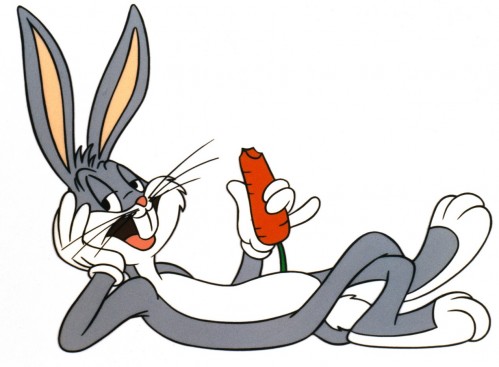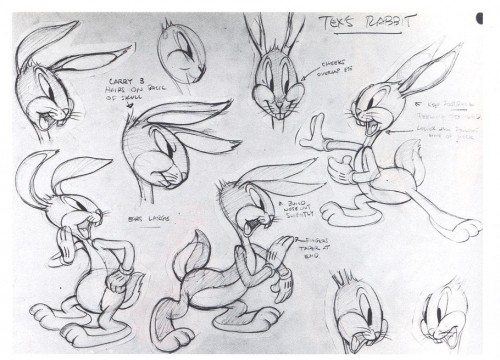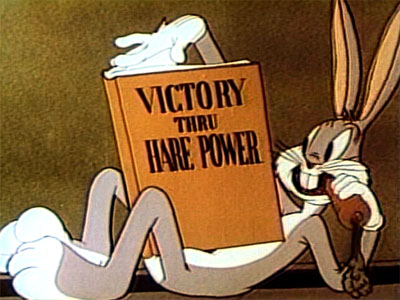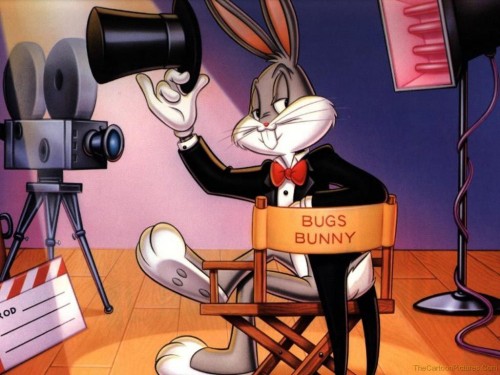http://onanimation.com/?attachment_id=7078
Monday 17 February 2014
Saturday 15 February 2014
Friday 14 February 2014
Origin of Acme
http://www.todayifoundout.com/index.php/2013/03/the-origin-of-the-looney-tunes-acme-name/
Without a doubt, the company name is used ironically in the Looney Tunes cartoons. “ACME” comes from the Greek, meaning “peak” / “zenith” / “prime”, so in the case of the company, essentially meaning “best”, when in fact the products offered by the corporation in the show are invariably prone to disaster, something which ACME even acknowledges through its slogan – “Quality is our #1 dream”.
In the 1920s alphabetized phone books – like the Yellow Pages – were growing in popularity, resulting in businesses re-branding under a different name in order to get to the top of the list and get seen by more people. ACME was a hugely popular choice for a name at the time, since the letters AC are close to the beginning of the alphabet and the definition of the word suggests superiority.
Chuck Jones – writer, director, and animator who worked on Merrie Melodies and, of course, Looney Tunescartoons for over 3 decades – touched upon the name’s origin in an interview carried out for the 2009 filmChuck Jones: Memories of Childhood, in which he explained:
Since we had to search out our own entertainment, we devised our own fairy stories. If you wanted a bow and arrow, you got a stick. If you wanted to conduct an orchestra, you got a stick. If you wanted a duel, you used a stick. You couldn’t go and buy one. That’s where the term ACME came from. Whenever we played a game where we had a grocery store or something, we called it the ACME Corporation. Why? Because in the yellow pages if you looked, say, under drugstores, you’d find the first one would be Acme Drugs. Why? Because “AC” was about as high as you could go. It means the best, the superlative.
So although the fictional company may boast an interesting line of products – including the ACME Building Disintegrator and ACME Ultimatum Dispatcher – the origin of its name isn’t quite as exciting. It was simply a commonly used name at the time, inferring a company was the best, which the guys at Looney Tunes adopted and used with their tongues firmly planted in their cheeks.
Thursday 13 February 2014
Censored Eleven
http://museumofuncutfunk.com/2011/10/05/the-censored-eleven/
The Censored Eleven is a group of Looney Tunes and Merrie Melodies cartoons that were withheld from syndication by United Artists in 1968. UA owned the distribution rights to the Associated Artists Productions (A.A.P.) library at that time and decided to pull these eleven cartoons from broadcast because they are based on racist depictions of Blacks and are deemed too offensive for contemporary audiences. The ban has been upheld by UA and the successive owners of the pre-August 1948 Looney Tunes / Merrie Melodies catalog, including Ted Turner, and these shorts have not been officially broadcast on television since the late 1960’s.
In the case of the Censored Eleven, racist themes are so essential and so completely pervade the cartoons that the copyright holders believe that no amount of selective editing can ever make them acceptable for distribution. However, many animation fans view these cartoons as art and feel that despite their overt racism that they should be seen. Animation historians and film scholars defend two of these cartoons directed by Bob Clampett, Coal Black and the Sebben Dwarfs and Tin Pan Alley Cats. The former, a jazz-based parody of Walt Disney’s Snow White and the Seven Drawfs, is frequently included on lists of the “greatest” cartoons ever made, while the latter is a hot jazz re-interpretation of Clampett’s now-classic 1938 short Porky in Wackyland.
Author Michelle Hass wrote: “. . . some even look at Clampett’s Jazz cartoons and cry racism when Clampett was incredibly ahead of his time and was a friend to many of the greats of the LA jazz scene. All of the faces you see in Tin Pan Alley Cats and Coal Black and de Sebben Dwarfs are caricatures of real musicians he hung out with at the Central Avenue jazz and blues clubs of the 1940’s. He insisted that some of these musicians be in on the recording of the soundtracks for these two cartoons.”
A history Of Bugs
http://www.neatorama.com/2010/11/08/a-brief-history-of-bugs-bunny/#!Rlptg
IMPRESSIVE STATS
Bug Bunny is the world's most popular rabbit:
* Since 1939, he has starred in more than 175 films.
* He's been nominated for three Oscars, and won one -in 1958, for "Knighty Knight, Bugs" (with Yosemite Sam).
* Every year from 1945 to 1961, he was voted "top animated character" by movie theater owners (when they still showed cartoons in theaters).
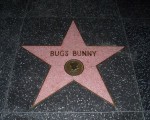 * In 1985 he became only the 2nd cartoon character to be given a star on the Hollywood Walk of Fame (Mickey Mouse was the first).
* In 1985 he became only the 2nd cartoon character to be given a star on the Hollywood Walk of Fame (Mickey Mouse was the first).* For almost 30 years, starting in 1960, he had one of the top-rated shows in Saturday morning TV.
* In 1976, when researchers polled Americans on their favorite characters, real and imaginary, Bugs came in second ...behind Abraham Lincoln.
THE INSPIRATIONS
Bugs was born in the 1930s, but cartoon historians say his ancestry goes further back. A few direct antecedents:
* Zomo. You may not have heard of this African folk-rabbit. but he's world famous. Joe Adamson writes in Bugs Bunny: Fifty Years and Only One Grey Hare:
Like jazz and rock'n'roll, Bugs has at least some of his roots in black culture. Zomo is the trickster rabbit from Central and Eastern Africa who gained audience sympathy by being smaller than his oppressors and turning the tables on them through cleverness -thousands of years before Eastman invented film. A con artist, a masquerader, ruthless and suave, in control of the situation. Specialized in impersonating women.
* Charlie Chaplin. "It was Chaplin who established that 'gestures and actions expressing attitude' give a screen character life." Adamson writes. The Looney Tunes directors, all fans of Chaplin, even stole many of his gags. For example:
The abrupt and shocking kiss Charlie plants [on] someone who's getting too closse for comfort in The Floorwalker went on to become one of Bugs' favorite ways to upset his adversaries. [And] the walking broomstick in Bewitched Bunny does Chaplin's trademark turn, with one foot in the air, at every corner.
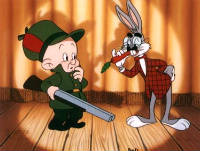 There are literally dozens of other Chaplin rip-offs. Bugs also lifted bits from silent comedians Harold Lloyd and Buster Keaton.
There are literally dozens of other Chaplin rip-offs. Bugs also lifted bits from silent comedians Harold Lloyd and Buster Keaton.* Groucho Marx. "Bugs uses his carrot as a prop, just as Groucho used his cigar," points out Stefan Kanfer in Serious Business. "Eventually Bugs even stole Marx's response to an insult: 'Of course you know, this means war!' "
TIMELINE
1937: Warner Bros. animation director Tex Avery makes "Porky's Duck Hunt." Porky Pig hunted a screwball duck named Daffy -"who didn't get scared and run run away when somebody pointed a gun at him, but leapt and hopped all over the place like a maniac." "When it hit the theaters," recalls another director, "it was like an explosion."
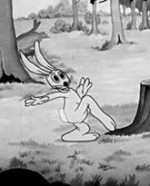 1938: Warner Bros. director Ben "Bugs" Hardaway remakes the cartoon with a rabbit instead of a duck, as "Porky's Hare Hunt". Says one of Bugs' creators: "That rabbit was just Daffy Duck in a rabbit suit."
1938: Warner Bros. director Ben "Bugs" Hardaway remakes the cartoon with a rabbit instead of a duck, as "Porky's Hare Hunt". Says one of Bugs' creators: "That rabbit was just Daffy Duck in a rabbit suit."1939: Bugs Hardaway decides to remake "Porky's Hare Hunt" with a new rabbit (as "Hare-um Scare-um"). Cartoonist Charlie Thorson comes up with a gray and white rabbit with large buck teeth. He labels his sketch "Bugs' Bunny".
1940: Director Tex Avery becomes the real father of Bugs Bunny with "A Wild Hare". Bugs is changed from a Daffyesque lunatic to a streetsmart wiseass. "We decided he was going to be a smart alec rabbit, but casual about it," Avery recalled. "His opening linewas 'What's up, Doc? ...It floored 'em! ...Here's a guy with a gun in his face! ...They expected the rabbit to scream, or anything but make a casual remark... It got such a laugh that we said, 'Let's use that every chance we get.' It became a series of 'What's up, Docs?' That set his entire character, He was always in command, in the face of all types of dangers."
* Bugs also gets his voice in "A Wild Hare". Mel Blanc, who did most Looney Tunes voices, had been having a hard time finding one for the rabbit... until Bugs Hardaway showed him the latest sketch for "A Wild Hare". Blanc wrote:
He'd obviously had some work done. His posture had improved, he'd shed some weight, and his protruding front teeth weren't as pronounced. The most significant change, however, was in his facial expression. No longer just goofy, he was a sly looking rascal.
"A tough little stinker, isn't he?" Hardaway commented... and the light went on in Blanc's brain.
A tough little stinker... In my mind I heard a Brooklyn accent... To anyone living west of the Hudson River at that time, Brooklynites were associated with con artists and crooks... Consequently, the new, improved Bugs Bunny wouldn't say jerk, he'd say joik.
* The rabbit is now so popular he needs a name. According to some sources, he is about to be dubbed "Happy Rabbit". Tex Avery wants "Jack E. Rabbit". But when Thorson's year-old drawing labeled "Bugs' Bunny" is turned up, producer Leon Schlesinger chooses that. Avery hates it. "That's sissy," he complains. "Mine's a rabbit. A tall, lanky, mean rabbit. He isn't a fuzzy little bunny!" But the name sticks.
1941: Bugs Bunny becomes competitive. Four extremely talented directors -Avery, Fritz Freleng, Bob Clampett, and Chuck Jones- try to top each other with new gags and aspects of Bugs' personality. It's the key to the character's success -he's constantly growing. "As each director added new levels to this character," Adamson explains, "it was picked up by others and became part of the mix."
1943: Animator Robert McKimson (later a director himself), working for Bob Clampett, refines Bugs' features into what they are today. "We made him cuter, brought his head and cheeks out a little more and gave him just a little nose," McKimson says. He looks more "elfin" and less "ratlike" now.
1945: During World War II, Bugs has become a "sort of a national mascot." Critic Richard Schickel writes: "In the war years, when he flourished most gloriously, Bugs Bunny embodied the cocky humor of a nation that had survived its economic crisis [in surprisingly good shape], and was facing a terrible war with grace, gallantry, humor and and solidarity that was equally surprising." By the end of the war, Bugs isn't just a cartoon character, but an American icon.
BUGS FACTS
Saved by a Hare. The inspiration for the original rabbit came from Walt Disney. In 1935 Disney put out a cartoon featuring a character called Max Hare. Hardaway's rabbit looks suspiciously like Max.
Trademarks. Where did Bugs' carrot-crunching and "What's up, Doc?" come from? No one's sure, but experts have suggested they might have been inspired by a couple of popular films.
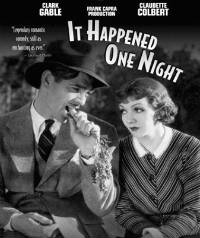 * In Frank Capra's 1934 Oscar-winning comedy, It Happened One Night, Clark Gable nervously munches on carrots.
* In Frank Capra's 1934 Oscar-winning comedy, It Happened One Night, Clark Gable nervously munches on carrots.* In the classic 1939 screwball comedy My Man Godfrey, William Powqell uses the line, "What's up, Doc?" repeatedly.
On the other hand, Tex Avery had a habit of calling everyone Doc -so he may have inspired the phrase. (Mel Blanc -Bugs' voice- also claims in his autobiography that he ad-libbed the line, but he seems to take credit for everything- so we don't believe him.)
Tough Act. Blanc said that recording the "What's up, Doc?" line turned out to be the most physically challenging part of doing the voice:
"What's up, Doc?" was incomplete without the sound of the rabbit nibbling on the carrot, which presented problems. First of all, I don't especially like carrots, at least not raw. [Ed note: In another BR, we erroneously reported that he was allergic to carrots. Oops.] And second, I found it impossible to chew, swallow, and be ready to say my next line. We tried substituting other vegetables, including apples and celery, with unsatisfactory results. The solution was to stop recording so that I could spit out the carrot into the wastebasket and then proceed with the script. In the course of a recording session I usually went through enough carrots to fill several wastebaskets. Bugs Bunny did for carrots what Popeye did for spinach. How many...children were coerced into eating their carrots by mothers cooing... "but Bugs Bunny eats his carrots." If only they had known.
Eat Your Veggies. Actually, there were pressures to switch from carrots. "The Utah Celery Company of Salt Lake City offered to keep all the studio's staffers well supplied with their product if Bugs would only switch from carrots to celery," Adamson reports. "[And] later, the Broccoli Institute of America strongly urged Bugs Bunny to sample their product once in a while... Mel Blanc would have been happy to switch... but carrots were Bugs's trademark."
Surprise Hit. To his creators, Bugs Bunny was just another character that would probably run in a few cartoons and fade unnoticed into obscurity. "We didn't feel that we had anything," Avery recounted years later, "until we got it on the screen and it got a few laughs. After we ran it and previewed it and so forth, Warner liked it, the exhibitors liked it, and so of course [the producer] ran down and said, 'Boy, give me as many of these as you can!' Which we did."
Bug Bunny became so popular with the public that he got laughs even when he didn't deserve them. "He could do no wrong," remembers dialog writer Michael Maltese. "We had quite a few lousy Bugs Bunnies. We'd say, 'Well he haven't got time. Let's do it.' And we'd do it, and the audience would laugh. They loved that rabbit."
Looney Tunes: Wartime & Propaganda
During the war looney tunes turned to create two types of cartoons: ones to escape from reality of the newcasts and ones that played on the topicality of it. working in a defence plant, being drafted, etc.
Bugs bunny captured the american spirit, bug’s can-do attitude gave americans relatable cartoon character. As bugs had just been created in the recent years, his development during this period shaped what we know as bugs today and is what made him rise to success.
The character of Bugs Bunny became very developed between 1941-1942 due to the war.
Typical trademarks of these cartoons that are usually spoofed: propaganda elements, racist caricatures, outdated references to the war effort (i.e., Shout Outs to save scrap iron, buy war bonds, or grow a Victory Garden). Adolf Hitler, Benito Mussolini, and/or Emperor Hirohito often make a cameo.
http://en.wikipedia.org/wiki/Bugs_%26_Daffy:_The_Wartime_Cartoons
http://tvtropes.org/pmwiki/pmwiki.php/Main/WartimeCartoon
Bugs Bunny Nips the Nips (1944):
http://youtube.com/watch?v=-w2F3planCk
Herr Meets Hare (1945):
http://youtube.com/watch?v=lIQch389Gyk
Buy War Bonds!(1942):
http://www.youtube.com/watch?v=_TUPUbvO0eU
Daffy The Commando (1943):
http://www.youtube.com/watch?v=by3FVKdaQyE&am
Tokio Jokio (1943):
http://www.youtube.com/watch?v=3_km9IFzzHo&am
Scrap happy Daffy (1943):
http://youtube.com/watch?v=Bnpdwn1mR6c&fe
Porky Pig and Old Glory (1939):
http://youtube.com/watch?v=utkBu-mqi-c&fe
Bugs bunny captured the american spirit, bug’s can-do attitude gave americans relatable cartoon character. As bugs had just been created in the recent years, his development during this period shaped what we know as bugs today and is what made him rise to success.
The character of Bugs Bunny became very developed between 1941-1942 due to the war.
Typical trademarks of these cartoons that are usually spoofed: propaganda elements, racist caricatures, outdated references to the war effort (i.e., Shout Outs to save scrap iron, buy war bonds, or grow a Victory Garden). Adolf Hitler, Benito Mussolini, and/or Emperor Hirohito often make a cameo.
http://en.wikipedia.org/wiki/Bugs_%26_Daffy:_The_Wartime_Cartoons
http://tvtropes.org/pmwiki/pmwiki.php/Main/WartimeCartoon
Bugs Bunny Nips the Nips (1944):
http://youtube.com/watch?v=-w2F3planCk
Herr Meets Hare (1945):
http://youtube.com/watch?v=lIQch389Gyk
Buy War Bonds!(1942):
http://www.youtube.com/watch?v=_TUPUbvO0eU
Daffy The Commando (1943):
http://www.youtube.com/watch?v=by3FVKdaQyE&am
Tokio Jokio (1943):
http://www.youtube.com/watch?v=3_km9IFzzHo&am
Scrap happy Daffy (1943):
http://youtube.com/watch?v=Bnpdwn1mR6c&fe
Porky Pig and Old Glory (1939):
http://youtube.com/watch?v=utkBu-mqi-c&fe
Subscribe to:
Posts (Atom)

























